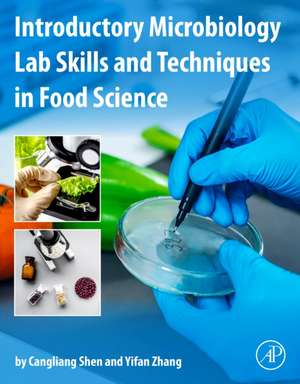Introductory Microbiology Lab Skills and Techniques in Food Science
Autor Cangliang Shen, Yifan Zhangen Limba Engleză Paperback – 8 noi 2021
- Presents step-by-step lab procedures with photos in lab setting.
- Includes case studies of microorganism causing infectious disease.
- Provides clinical microbial lab tasks to mimic real-life situations applicable to industry.
Preț: 568.90 lei
Preț vechi: 746.69 lei
-24% Nou
Puncte Express: 853
Preț estimativ în valută:
108.86€ • 113.96$ • 90.07£
108.86€ • 113.96$ • 90.07£
Carte tipărită la comandă
Livrare economică 29 martie-12 aprilie
Livrare express 01-07 martie pentru 66.49 lei
Preluare comenzi: 021 569.72.76
Specificații
ISBN-13: 9780128216781
ISBN-10: 0128216786
Pagini: 174
Ilustrații: Approx. 100 illustrations
Dimensiuni: 152 x 229 x 12 mm
Greutate: 0.25 kg
Editura: ELSEVIER SCIENCE
ISBN-10: 0128216786
Pagini: 174
Ilustrații: Approx. 100 illustrations
Dimensiuni: 152 x 229 x 12 mm
Greutate: 0.25 kg
Editura: ELSEVIER SCIENCE
Cuprins
1. Introduction of microbial and chemical safety and lab notebook record
2. Practice of Bright-field Microscopy
3. Preparation of Smears and Simple Stain Practice
4. Gram Stain Practice
5. Acid-Fast Stain Practice
6. Endospore Stain Practice
7. Aseptic Technique-Bacteria Transfer and Streak Plating
8. Lab Practice Test 1-Identify unknown bacteria using Gram stain
9. Introduction of bacteria medium, Nutritional Requirements (Synthetic and Complex Media) Selective & Differential Media (McConkey, Manitol Salt, Blood agar)
10. Lab Practice Test 2-Dilution technology and quiz
11. Numeration bacteria population by pour-plating
12. Numeration bacteria population by spread-plating
13. External Conditions for bacterial growth (Temperature, pH, oxygen, osmatic)
14. Cultivation of anaerobic bacteria
15. Biochemistry test of bacteria-1 (Urease Test, Carbohydrate Fermentation, catalase test, oxidase test)
16. Biochemistry test of bacteria-2 (Nitrate Reduction, Decarboxylation & Deamination of Amino Acids, IMViC Test, Hydrogen Sulfide, Motility and Indole Test)
17. Biochemistry test of bacteria-3 (API20e and enterotube II)
18. Extracellular Enzymatic Activities of Microorganisms
19. Case study 1 (Bacteria cause upper respiratory tract diseases)
20. Clinical lab practice 2-Urine sample bacteria isolation and numeration
21. Case study 2 (Bacteria cause intestinal tract and urine tract diseases)
22. Isolation of phage and PFU determination
23. Antibiotic Sensitivity Testing and Evaluation of Antiseptics/Disinfectants
24. Microbial Counts of Food Product
25. Total Plate Count & Coliform Count of Pond Water
2. Practice of Bright-field Microscopy
3. Preparation of Smears and Simple Stain Practice
4. Gram Stain Practice
5. Acid-Fast Stain Practice
6. Endospore Stain Practice
7. Aseptic Technique-Bacteria Transfer and Streak Plating
8. Lab Practice Test 1-Identify unknown bacteria using Gram stain
9. Introduction of bacteria medium, Nutritional Requirements (Synthetic and Complex Media) Selective & Differential Media (McConkey, Manitol Salt, Blood agar)
10. Lab Practice Test 2-Dilution technology and quiz
11. Numeration bacteria population by pour-plating
12. Numeration bacteria population by spread-plating
13. External Conditions for bacterial growth (Temperature, pH, oxygen, osmatic)
14. Cultivation of anaerobic bacteria
15. Biochemistry test of bacteria-1 (Urease Test, Carbohydrate Fermentation, catalase test, oxidase test)
16. Biochemistry test of bacteria-2 (Nitrate Reduction, Decarboxylation & Deamination of Amino Acids, IMViC Test, Hydrogen Sulfide, Motility and Indole Test)
17. Biochemistry test of bacteria-3 (API20e and enterotube II)
18. Extracellular Enzymatic Activities of Microorganisms
19. Case study 1 (Bacteria cause upper respiratory tract diseases)
20. Clinical lab practice 2-Urine sample bacteria isolation and numeration
21. Case study 2 (Bacteria cause intestinal tract and urine tract diseases)
22. Isolation of phage and PFU determination
23. Antibiotic Sensitivity Testing and Evaluation of Antiseptics/Disinfectants
24. Microbial Counts of Food Product
25. Total Plate Count & Coliform Count of Pond Water
Recenzii
"This is a must-have book for any tertiary institution teaching food science with food microbiology but should also be a reference book in any laboratory doing food microbiology. This book has everything you need to ensure that you can practise and perfect classical laboratory microbiological techniques, from preparation of smears and staining, introduction and classification of different media, numeration and plating techniques and cultivation of bacteria, to case studies, quizzes and practice activities, to antibiotic susceptibility testing and isolation of phages.The book covers all aspects of general food microbiology and is set out in 25 chapters that are easy to read and follow....
What is really useful about this book is that the various steps are described with the aid of photographs or diagrams, which make it very easy to understand....
I would highly recommend this book as a guide to any food microbiology practical class." --FST Magazine
What is really useful about this book is that the various steps are described with the aid of photographs or diagrams, which make it very easy to understand....
I would highly recommend this book as a guide to any food microbiology practical class." --FST Magazine
